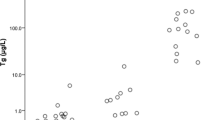Abstract
A monoclonal antibody to human thyroglobulin was radiolabelled with 123I NaI and shown to be a stable and biologically active reagent in vivo. When injected intravenously into 12 patients with cancer of the thyroid on thyroxine-replacement therapy, 6 of the 12 patients had localization of the labelled antibody in tumour sites. These results were compared to 131I scans done on the same patients 1 month after stopping thyroxine. The biological half-life of the antibody in the blood was influenced by the levels of circulating thyroglobulin.
Similar content being viewed by others
References
Black EG, Cassoni A, Gimlette TMD, Harmer CL, Maisey MN, Oates GD, Hoffenberg R (1981) Serum thyroglobulin in thyroid cancer. Lancet 2:443–445
Cerottini JC, Isliker H (1967) Transport d'agents cytostatiques par les proteins plasmatiques. 1. Penetration de la serumalbumine dans les cellules tumorales. Eur J Cancer 3:111–115
Epenetos AA, Britton KE, Mather S, Shepherd J, Granowska M, Taylor-Papadimitriou J, Nimmon CC, Durbin H, Hawkins LR, Malpas JS, Bodmer WF (1982) Targeting of iodine-123 labelled tumour-associated monoclonal antibodies to ovarian, breast and gastrointestinal tumours. Lancet 2:999–1005
Goldenberg DM, Preston DF, Primus FJ, Hansen HJ (1974) Photoscan localization of GW-39 tumours in hamsters using radiolabelled anticarcinoembryonic antigen immunoglobulin G. Cancer Res 34:1–9
Köhler G, Milstein C (1975) continuous cultures of fused cells secreting antibody of predefined specificity. Nature 256:495–497
Köhler G, Milstein C (1976) Derivation of specific antibdoy-producing tissue culture and tumour lines by cell fusion. Eur J Immunol 6:511–519
Mach JP, Buchegger F, Forni M, Ritschard J, Berche C, Lumbroso JD, Schreyer M, Girardet C, Accolla RS, Carrel S (1981) Use of radiolabelled monoclonal anti-CEA antibodies for the detection of human carcinomas by external photoscanning and tomoscintigraphy. Immunol Today 2:239–249
Salacinski PR, Hope J, McLean C, Clement-Jones V, Sykes J, Price J, Lowry PJ (1979) A new simple method which allows theoretical incorporation of radio-iodine into proteins and peptides without damage. J Endocrinol 81:131P
Spencer DR (1977) On body composition and haematology. In: Seligson D (ed) Handbook series in clinical laboratory science, section A. Nuclear medicine, vol 1. CRC Press, Cleveland, pp 190–204
Van Herle AJ, Uller RP (1975) Elevated serum thyroglobulin —a marker of metastases in differentiated thyroid carcinoma. J Clin Invest 56:272–277
Author information
Authors and Affiliations
Rights and permissions
About this article
Cite this article
Shepherd, P.S., Lazarus, C.R., Mistry, R.D. et al. Detection of thyroid tumour using a monoclonal 123I anti-human thyroglobulin antibody. Eur J Nucl Med 10, 291–295 (1985). https://doi.org/10.1007/BF00251298
Received:
Accepted:
Issue Date:
DOI: https://doi.org/10.1007/BF00251298



